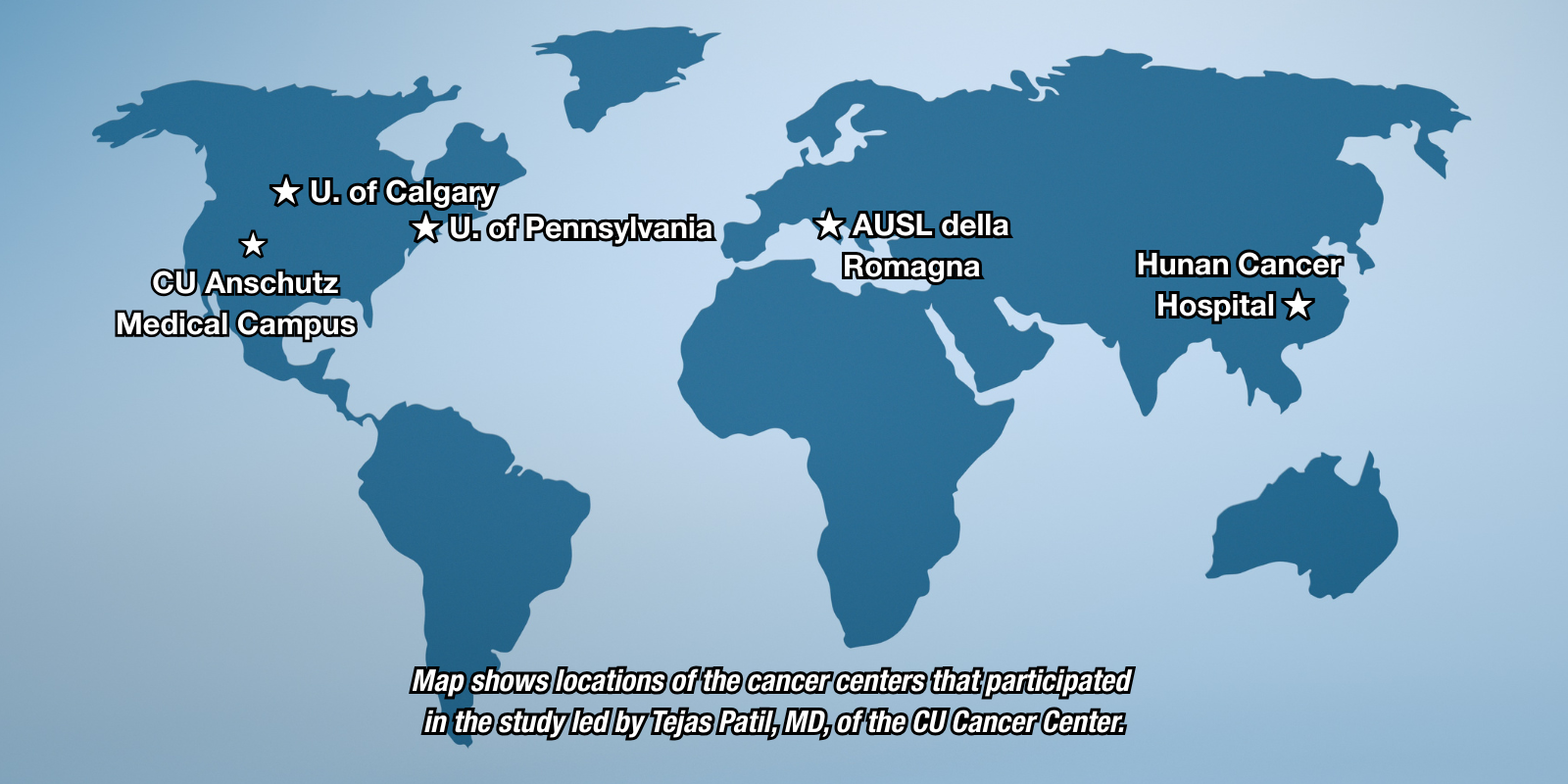An international study led by a University of Colorado Cancer Center member examined the benefits of treating certain types of lung cancer with a combination of a targeted therapy called osimertinib along with chemotherapy rather than using chemo alone.
“This was an unanswered question in the field, and there’s been a variance in practice patterns across the United States and globally,” says Tejas Patil, MD, assistant professor in the CU Department of Medicine’s Division of Medical Oncology.
Patil led the study, “The efficacy of continuing osimertinib with platinum pemetrexed chemotherapy upon progression in patients with metastatic non-small cell lung cancer harboring sensitizing EGFR mutations,” which was published in the journal Lung Cancer.
The study involved patients and researchers from the CU Cancer Center as well as cancer facilities in Canada, China, Italy, and the University of Pennsylvania. CU Cancer Center member and medical oncology professor D. Ross Camidge, MD, PhD, Patil’s mentor and a co-author of the study, says, “The extent of worldwide collaboration he made happen was amazing.”
→ A Combination of Targeted Therapies Proves Effective Against Mutation-Driven Lung Cancer
Blocking the EGFR pathway
Patil and his colleagues sought answers to a mystery involving a treatment strategy for non-small cell lung cancer (NSCLC), which accounts for 80% to 85% of all lung cancer cases.
Osimertinib, a pill sold under the brand name Tagrisso, is a type of targeted therapy called a small molecule inhibitor that’s used to treat a type of NSCLC involving a mutation of a gene found on the surface of many cells, known as the epidermal growth factor receptor gene (EGFR).
EGFR mutations cause uncontrolled cell division and tumor growth. In about 25% to 30% of NSCLC cases, EGFR mutations are the key “oncogenic driver,” functioning as an “on switch” for cancer cell growth, Patil says.
EGFR mutations “are much more prevalent in patients who’ve never smoked, in women, and in patients from East Asian backgrounds,” Patil says.
Osimertinib “blocks the EGFR pathway and short circuits cancer cell growth,” Patil says. It’s a standard-of-care option for treating certain types of EGFR+ NSCLC. It’s also valuable in helping to ward off the spread of cancer to the brain.
→ ‘A Way of Embodying Hope’: 5-Year Lung Cancer Survivors Celebrate
With or without chemo?
In many patients, particularly those whose cancer has spread from the lungs to nearby tissue or other parts of the body, osimertinib improves progression-free survival – the period of time between when a patient starts treatment and when scans show the treatment is no longer working – as well as overall survival. But some patients eventually see progression of their cancer return while on the drug.
Currently, for EGFR+ NSCLC, the median length of progression-free survival is roughly 18 to 20 months, and median overall survival is about 38 months, Patil says.
“When patients’ cancer progresses on osimertinib, they typically would get chemotherapy after the osimertinib stopped working. And the fundamental question we were asking was, what is the benefit of combining the osimertinib they were already on with chemotherapy, rather than stopping the osimertinib and just doing chemotherapy by itself?”
Patil and his colleagues set out to learn whether combining osimertinib with a chemotherapy regimen that includes pemetrexed (brand name: Alimta) along with platinum-based drugs could help EGFR+ NSCLC patients with cancer progression more than chemo by itself.
Platinum-pemetrexed chemotherapy is often used as a “next line” regimen when an initial chemotherapy treatment fails or produces severe side effects, but its value combined with osimertinib was not known before Patil’s new study.
→ How Unusual is ‘Big Bang Theory’ Actress Kate Micucci’s Lung Cancer?
159 patients in four countries
Patil and his colleagues analyzed data from 2013 to 2023 on 159 patients in four countries with EGFR+ NSCLC whose cancer had progressed on osimertinib. The study looked at 50 patients who were treated with osimertinib together with platinum-pemetrexed chemotherapy, and 109 treated with chemo alone.
This was a “retrospective cohort” study looking at past data, “based on how people practice medicine in the real world,” not a clinical trial involving enrolled patients, Patil says.
“We found that there was improved progression-free survival when you combined osimertinib with chemo,” he says. “We also found a reduction in the percentage of patients who developed brain metastases when you kept the osimertinib going.” But the study generally found no improvement in overall survival periods.
Patil says he’ll be interested in seeing results from an ongoing clinical trial called Mariposa-2. “They're asking the exact same question about combining therapies, but with a different EGFR drug, called amivantamab.”
If the Mariposa-2 trial also shows no overall survival benefit, he says, “then I think we need to come back to the drawing board to think about how we can help patients who stop responding to first-line treatments with some newer treatment strategies in the second line. That’s where I think this field is going.”
→ CU Cancer Center Offers Resources to Help Prevent Lung Cancer
‘That’s wonderful to see’
A key value in including overseas partners in Patil’s study, he says, is that EGFR+ NSCLC is treated differently in different countries.
“In the United States, at least at the cancer centers we worked with, it’s very common to continue the osimertinib with the chemotherapy,” he says. “But we needed a control, and the control was just chemotherapy by itself, and one practical way of doing that was to reach out to investigators where the country’s health care plans don’t allow this practice of keeping patients on osimertinib with chemo. And that was Italy and Canada, and to some extent China, where the practice patterns were more mixed.”
It took “a lot of work” to reach regulatory agreements with the various cancer centers and collect the data sets, Patil adds. “What was really cool and humbling about this was how many investigators were happy to participate. This was uncompensated work – no one was paying them to do the data extraction. They just wanted to do it because they thought it was a good question. I mean, a lot of people have been wrestling with this for a long time. This definitely contributes to the body of literature, and I’m pretty proud of this project.”
Says Camidge: “One of Tejas’s strengths is being a good organizer of people in a way that makes people want to follow his lead, feel like they’re respected, and feel like they’re working towards a common goal. For me as his mentor, that's wonderful to see.”
Besides Patil and Camidge, CU Cancer Center members and Division of Medical Oncology faculty who contributed to the study are Paul Bunn MD, and Erin Schenk, MD, PhD.




.png)